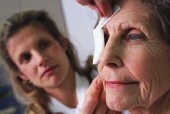
MONDAY, Jan. 23 (HealthDay News) — Using human embryonic stem cells to treat the eye disease macular degeneration appears to be safe and leads to some vision improvement, a small, early-stage study found.
The study included one elderly patient and one younger adult patient with different types of macular degeneration that had led to severe vision loss.
After four months, the embryonic stem cell transplants seemed safe and both patients had some improvement in vision, the U.S. researchers said.
But researchers cautioned that the research is preliminary and far more study is needed before the practice might become widespread.
The study, published online Jan. 23 in The Lancet, is the first report of the use of human embryonic stem cells (hESC) in humans for any purpose, the researchers said in a news release from the journal.
One patient was a woman in her 70s with dry age-related macular degeneration (AMD), which is the leading cause of blindness in the developed world. The other patient was a woman in her 50s with Stargardt’s macular dystrophy, the most common type of macular degeneration in younger patients. Both were legally blind.
Both patients received transplants of retinal pigment epithelium (RPE) derived from human embryonic stem cells into what’s called the subretinal space (under the retina of the eye) in one eye. The patients received low-dose immunosuppression therapy, which was gradually reduced after six weeks.
Follow-up exams showed that the transplanted cells had attached to a part of the retina called Bruch’s membrane and survived throughout the study period. Four months after transplant, there were no signs of so-called teratoma formation — which occurs when stem cells turn into multiple cell types and form “incompatible” tissues that can include teeth and hair — or related problems. And there were no signs of rejection or abnormal cell growth, the researchers said.
“Our study is designed to test the safety and tolerability of hESC-RPE in patients with advanced-stage Stargardt’s macular dystrophy and dry age-related macular degeneration. So far, the cells seem to have transplanted into both patients without abnormal proliferation, teratoma formation, graft rejection, or other untoward pathological reactions or safety signals. Continued follow-up and further study is needed. The ultimate therapeutic goal will be to treat patients earlier in the disease processes, potentially increasing the likelihood of photoreceptor and central visual rescue,” wrote Dr. Robert Lanza, chief scientific officer at Advanced Cell Technology in Marlborough, Mass., and his colleagues.
“It has been over a decade since the discovery of human embryonic stem cells. This is the first report of hESC-derived cells ever transplanted into patients, and the safety and engraftment data to date looks very encouraging,” Lanza added in the journal news release.
“Although several new drugs are available for the treatment of the wet type of AMD, no proven treatments currently exist for either dry AMD or Stargardt’s disease. Despite the progressive nature of these conditions, the vision of both patients appears to have improved after transplantation of the cells, even at the lowest dosage. This is particularly important, since the ultimate goal of this therapy will be to treat patients earlier in the course of the disease where more significant results might potentially be expected,” he added.
Scientists believe that embryonic stem cells have the ability to “differentiate” — or grow — into most types of cells in the human body. But the use of such cells is controversial because it involves the destruction of a human embryo.
In an accompanying editorial, Dr. Anthony Atala, a professor and director of the Wake Forest Institute for Regenerative Medicine at Wake Forest School of Medicine, in North Carolina, wrote: “The potential to use human embryonic-derived cells with a therapeutic effect in patients is now finally realized … The ultimate therapeutic goal for patients with visual loss would be to treat them earlier in the disease processes, hopefully increasing the likelihood of visual rescue. Much remains to be seen — literally.”
More information
The U.S. National Eye Institute has more about age-related macular degeneration.

